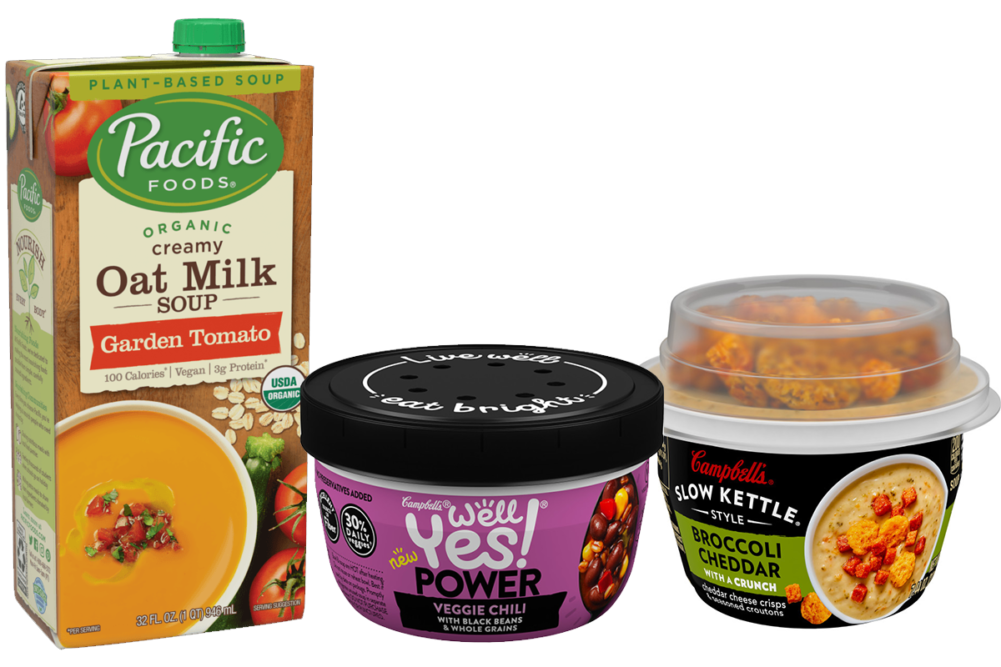
Soup category surges back after lull
CAMDEN, NJ. — The primary goal of the Campbell Soup Co.’s soup 2.0 strategy is simple — keep as many new users in the category as possible. From fiscal 2015 to 2019, Campbell’s soup sales were in decline and had a four-year compound annual growth rate (CAGR) of minus 2%. Between fiscal 2019 and 2021, the soup business CAGR surged to 6%, according to the company.
“In terms of soup, the category is stronger, more relevant and healthier than it's been in a long time,” said Christopher D. Foley, president of Campbell’s Meals & Beverages business unit, during the company’s Dec. 14 virtual investor day. “In home, soup occasions total 92 million each week with 22 million of these soup occasions coming from millennial households. Younger users are discovering the versatility of soup and are more likely to eat soup in between meal occasions throughout the day.”
The key tailwind supporting the company’s “soup 2.0” strategy is at-home eating. The market researcher Gartner is forecasting that 53% of the US workforce will be working remotely in 2022, the company said.
“This is good news, especially for a category like soup, and we’ve seen our share of soup occasions at lunch increase significantly,” Mr. Foley said. “The eating-at-home trend has grown and has also evolved. One key insight we are seeing is that consumers want to reduce the amount of time preparing meals even more, now just under 18 minutes. They’re fatigued from cooking at home and prepping complicated meals.”
Strategies management plans to employ to continue growing the soup business include modernizing the portfolio, broadening its strength and accelerating innovation. Mr. Foley identified cooking as an opportunity for modernization.
“Soup is such a great catalyst for simple meals, and we have seen significant growth in this space,” he said. “So, whether it’s adding healthier or more convenient forms or expanding our Pacific brands to bring organic or plant-based options, we see many ways to grow relevance and keep refreshing the cooking experience.”
Broadening the strength of the soup business will require ensuring each brand has clear differentiated spaces to allow incremental growth.
“On our Campbell’s brand and condensed soup business, it starts from a mentality of ready-to-create and from simple goodness,” Mr. Foley said. “For our Well Yes! brand, we’re continuing to innovate against eating well and feeling well. Pacific is our organic brand with crafted foods and a premium positioning. Chunky continues to be the soup that eats like a meal. Finally, Swanson is the secret to homemade cooking success.
“All five of these brands are in spaces that we feel good about for growth, and all will have unique areas of investment and innovation to continue to drive that growth. No one else brings such an iconic and unique range of brands to fully meet our consumers’ and our retailers' needs.”
The COVID-19 pandemic forced Campbell Soup to pause some of its innovation efforts and focus on supply continuity. As the market has adapted to the pandemic, the company is focusing innovation on texture, taste and functional wellness.
“We’ve had great success with our crunch in lines when we first launched with Slow Kettle and now our Campbell’s All Family Crunch,” Mr. Foley said. “We’ve taken some of our most iconic products, like Goldfish crackers, and connected them with tomato soup to bring a unique experience solution at lunchtime or snack time.”
He highlighted the range of flavors available in the Well Yes! brand of Power Bowls as on trend. Varieties include spiced chickpea, vegetable chili, harvest vegetable, Cajun style chicken and Southwest style chicken.
The Pacific brand will lead Campbell’s foray into functional wellness with plant-based broths, oat milk soups and wellness bone broth. The company also announced plans to expand Pacific into the sauce category in 2022.
“We have made strong progress as we transform the soup category in the profitable center of the store,” Mr. Foley said. “We will continue to stay focused as we work to modernize soup to ensure it stays relevant for tomorrow's consumers. Our mission to unlock growth is not over but we are very pleased with the strength of the foundation we have built on this important business.”
Analysts participating in the investor day presentation asked management to outline soup category growth opportunities beyond pandemic-induced trends.
“One of the things that we do feel good about is that in the midst of elevated demand and certainly in (a) terrible set of circumstances, there is no question about the tailwind that has come from in-home consumption and the elevated demand across most all of our categories,” said Mark A. Clouse, president and chief executive officer. “But I do think our performance on share is an important place where we have really emphasized in this moment how do we establish better relationships with our brands and consumers, how do we take the opportunity of being in this moment to solidify some of those relationships, especially with younger households …”
Mr. Clouse added that the soup category is often thought of as a homogenous business but plays a lot of different roles in consumer eating occasions.
“I think that’s one of the reasons that we feel so good about our portfolio because it allows us to reach a variety of different consumers but also a variety of different occasions,” he said. “And I think that is going to be part of the compelling kind of win in soup 2.0 through this lens of versatility that brings a more significant level of innovation, continued high levels of support.”
